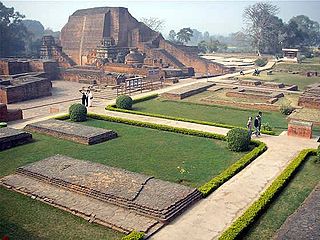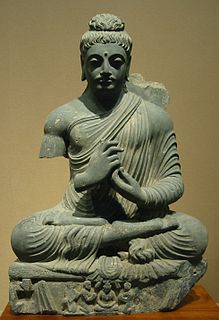Related Research Articles

Buddhist philosophy refers to the philosophical investigations and systems of inquiry that developed among various Buddhist schools in India following the parinirvana of the Buddha and later spread throughout Asia. The Buddhist path combines both philosophical reasoning and meditation. The Buddhist traditions present a multitude of Buddhist paths to liberation, and Buddhist thinkers in India and subsequently in East Asia have covered topics as varied as phenomenology, ethics, ontology, epistemology, logic and philosophy of time in their analysis of these paths.
Theravāda is the most commonly accepted name of Buddhism's oldest existing school. The school's adherents, termed Theravādins, have preserved their version of Gautama Buddha's teaching or Buddha Dhamma in the Pāli Canon for over two millennia.

Śūnyatā, translated most often as emptiness, vacuity, and sometimes voidness, is an Indian philosophical concept. Within Hinduism, Jainism, Buddhism and other philosophical strands, the concept has multiple meanings depending on its doctrinal context. It is either an ontological feature of reality, a meditative state, or a phenomenological analysis of experience.

Buddhaghosa was a 5th-century Indian Theravada Buddhist commentator, translator and philosopher. He worked in the Great Monastery (Mahāvihāra) at Anurādhapura, Sri Lanka and saw himself as being part of the Vibhajjavāda school and in the lineage of the Sinhalese Mahāvihāra.

The Avataṃsaka Sūtra or Buddhāvataṃsaka-nāma-mahāvaipulya-sūtra is one of the most influential Mahāyāna sutras of East Asian Buddhism. In Classical Sanskrit, avataṃsaka means garland, wreath, or any circular ornament, such as an earring. Thus, the title may be rendered in English as A Garland of Buddhas, Buddha Ornaments, or Buddha’s Garland. In Buddhist Hybrid Sanskrit, the term avataṃsaka means “a great number,” “a multitude,” or “a collection.” This is matched by the Tibetan title of the sutra, which is A Multitude of Buddhas.

Tathāgata is a Pali word; Gautama Buddha uses it when referring to himself or other Buddhas in the Pāli Canon. The term is often thought to mean either "one who has thus gone" (tathā-gata), "one who has thus come" (tathā-āgata), or sometimes "one who has thus not gone" (tathā-agata). This is interpreted as signifying that the Tathāgata is beyond all coming and going – beyond all transitory phenomena. There are, however, other interpretations and the precise original meaning of the word is not certain.

Prajñā or paññā, is a Buddhist term often translated as "wisdom", "intelligence", or "understanding". It is described in Buddhist texts as the understanding of the true nature of phenomena. In the context of Buddhist meditation, it is the ability to understand the three characteristics of all things: anicca ("impermanence"), dukkha, and anattā ("non-self"). Mahāyāna texts describe it as the understanding of śūnyatā ("emptiness"). It is part of the Threefold Training in Buddhism, and is one of the ten pāramīs of Theravāda Buddhism and one of the six Mahāyāna pāramitās.
Maitrī means benevolence, loving-kindness, friendliness, amity, good will, and active interest in others. It is the first of the four sublime states (Brahmaviharas) and one of the ten pāramīs of the Theravāda school of Buddhism.
Upādāna is a Sanskrit and Pali word that means "fuel, material cause, substrate that is the source and means for keeping an active process energized". It is also an important Buddhist concept referring to "attachment, clinging, grasping". It is considered to be the result of taṇhā (craving), and is part of the dukkha doctrine in Buddhism.
The brahmavihārās are a series of four Buddhist virtues and the meditation practices made to cultivate them. They are also known as the four immeasurables or four infinite minds. The Brahma-viharas are:
- loving-kindness or benevolence (maitrī/mettā)
- compassion (karuṇā)
- empathetic joy (muditā)
- equanimity (upekṣā/upekkhā)
Saṅkhāra is a term figuring prominently in Buddhism. The word means 'formations' or 'that which has been put together' and 'that which puts together'.

Buddhism, also known as Buddha Dharma or Dharmavinaya, is an Indian religion or philosophical tradition based on a series of original teachings attributed to Gautama Buddha. Originating in ancient India as a movement professing śramaṇa between the 6th and 4th centuries BCE, it gradually spread throughout much of Asia via the Silk Road. Presently, it is the world's fourth-largest religion, with over 520 million followers (Buddhists) who comprise seven percent of the global population. Buddhism encompasses a variety of traditions, beliefs, and spiritual practices that are largely based on the Buddha's teachings and their resulting interpreted philosophies.

Saṃsāra in Buddhism and Hinduism is the beginningless cycle of repeated birth, mundane existence and dying again. Samsara is considered to be dukkha, suffering, and in general unsatisfactory and painful, perpetuated by desire and avidya (ignorance), and the resulting karma.
Karma is a Sanskrit term that literally means "action" or "doing". In the Buddhist tradition, karma refers to action driven by intention (cetanā) which leads to future consequences. Those intentions are considered to be the determining factor in the kind of rebirth in samsara, the cycle of rebirth.

Brahmā is a leading god (deva) and heavenly king in Buddhism. He is considered as a protector of teachings (dharmapala), and he is never depicted in early Buddhist texts as a creator god. In Buddhist tradition, it was the deity Brahma Sahampati who appeared before the Buddha and invited him to teach, once the Buddha attained enlightenment.

Hinduism and Buddhism have common origins in the culture of Ancient India. Buddhism arose in the eastern Ganges culture of northern India during the "second urbanisation" around 500 BCE. Hinduism developed out of the ancient Vedic religion, adopting numerous practices and ideas from other Indian traditions over time. Both religions have many shared beliefs and practices, but also pronounced differences that have led to much debate.

Bruce Alan Wallace is an American author and expert on Tibetan Buddhism. His books discuss Eastern and Western scientific, philosophical, and contemplative modes of inquiry, often focusing on the relationships between science and Buddhism. He is founder of the Santa Barbara Institute for Consciousness Studies.

Nirvana is "blowing out" or "quenching" of the activities of the worldly mind and its related suffering. Nirvana is the goal of the Buddhist path, and marks the soteriological release from worldly suffering and rebirths in saṃsāra. Nirvana is part of the Third Truth on "cessation of dukkha" in the Four Noble Truths, and the "summum bonum of Buddhism and goal of the Eightfold Path."
David J. Kalupahana (1936–2014) was a Buddhist scholar from Sri Lanka. He was a student of the late K.N. Jayatilleke, who was a student of Wittgenstein. He wrote mainly about epistemology, theory of language, and compared later Buddhist philosophical texts against the earliest texts and tried to present interpretations that were both historically contextualised and also compatible with the earliest texts, and in doing so, he encouraged Theravada Buddhists and scholars to reevaluate the legitimacy of later, Mahayana texts and consider them more sympathetically.
Zen is a school of Mahayana Buddhism that originated in China during the Tang dynasty, known as the Chan School, and later developed into various sub-schools and branches. From China, Chán spread south to Vietnam and became Vietnamese Thiền, northeast to Korea to become Seon Buddhism, and east to Japan, becoming Japanese Zen.
References
- ↑ "Heim, Maria R. | Faculty & Staff". Amherst College.
- ↑ "Maria R. Heim". John Simon Guggenheim Memorial Foundation.
- ↑ "Our People". Murty Classical Library of India.
- ↑ Sweeney, Jon M. "Words for the Heart by Maria Heim | Review | Spirituality & Practice". Spirituality & Practice: Resources for Spiritual Journeys.
- ↑ Sraman, Upali (2021). "Voice of the Buddha: Buddhaghosa on the Immeasurable Words by Maria Heim (review)". Philosophy East and West. 71 (2): 1–5. doi:10.1353/pew.2021.0038. ISSN 1529-1898.
- ↑ Berkwitz, Stephen C. (3 July 2019). "Voice of the Buddha: Buddhaghosa on the Immeasurable Words". Religion. 49 (3): 513–516. doi:10.1080/0048721X.2019.1623615. ISSN 0048-721X.
- ↑ Huntington, C. W. "Huntington on Heim, 'The Forerunner of All Things: Buddhaghosa on Mind, Intention, and Agency' | H-Buddhism". H-Net.
- ↑ Shulman, Eviatar (2016). "The Forerunner of All Things: Buddhaghosa on Mind, Intention, and Agency by Maria Heim (review)". Philosophy East and West. 66 (1): 360–367. doi:10.1353/pew.2016.0019. ISSN 1529-1898.